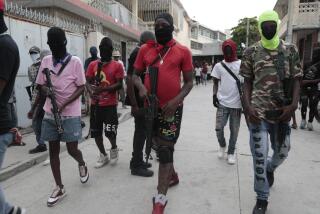A BALKAN ACCORD : The Bosnia Mission
- Share via
Some key points about the proposed peacekeeping mission to Bosnia-Herzegovina:
Who would go to Bosnia, and when?
AMERICAN: 23,000
OTHER NATIONS: 37,000
TOTAL FORCE: 60,000
A total force of as many as 60,000 is proposed. Of those, about 23,000 would be Americans and the balance would be from Western European and other contributing countries. The North Atlantic Treaty Organization would run the operation.
About 1,500 to 2,000 U.S. and NATO military specialists would be dispatched to Bosnia and nearby countries shortly after the accord’s initialing. They would set up headquarters and communications and begin repairing roads and bridges.
After the accord is signed--perhaps about two weeks from now--the rest of the heavily armed U.S.-NATO force would being pouring into the region. The contingent, known as the NATO-led Implementation Force, or IFOR, would be fully in place 45 to 60 days after the signing.
Where would the troops come from?
Most U.S. ground troops would come from the U.S. Army 5th Corps in Europe. Units of the 1st Armored Division have been training at Hohenfels, Germany, for the mission. Air Force and Navy jets would provide air cover, and Marines would stand by offshore.
Up to 3,000 reservists in the United States are likely to be called up, along with hundreds of logistics and support crews to handle transport planes and sealift vessels.
Britain and France already have a total of about 8,000 troops in the country as part of European force protecting U.N. peacekeepers; they would shift to NATO command. Most U.S. and allied troops would arrive by rail across Germany and Central Europe. But some would arrive by air, and some would go by barge via the Danube River to staging bases in Hungary and Croatia.
What is their mission?
The main goal would be to separate the forces of the three major factions in Bosnia--Muslims, Croats and Serbs--and then to steadily widen demilitarized zones between them to enforce the separation. Other activities would include protecting supply convoys and aid workers, patrolling borders, providing intelligence, logistics and air cover and restoring basic public utilities.
Who would command them?
U.S. Army Gen. George A. Joulwan, who is NATO’s supreme commander, would direct the overall operation from NATO headquarters in Brussels. U.S. Navy Adm. Leighton W. Smith, commander of NATO forces in Southern Europe, would be the tactical commander, shuttling between Sarajevo and Zagreb, Croatia’s capital.
Sources: Times staff and wire reports
More to Read
Sign up for Essential California
The most important California stories and recommendations in your inbox every morning.
You may occasionally receive promotional content from the Los Angeles Times.













